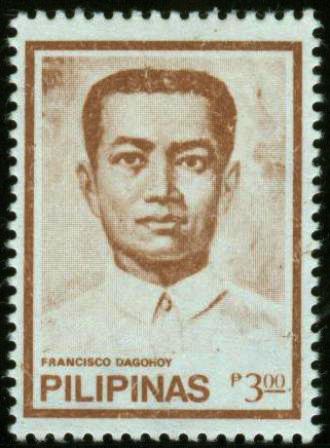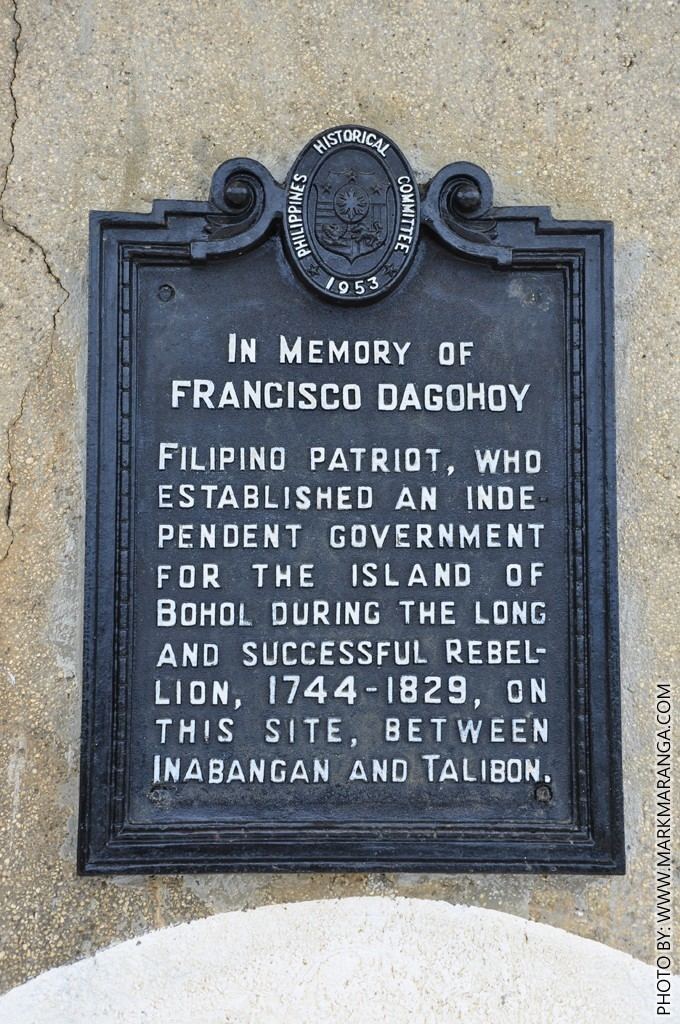Organization Boholano insurgents | Name Francisco Dagohoy | |
 | ||
Full Name Francisco Sendrijas Born 1724 Inabanga, Bohol(a residencia of Cebu) Died 1800, Talibon, Bohol, Philippines Similar Diego Silang, León Kilat, Apolinario Mabini | ||
Mma 101 the revolt of francisco dagohoy by
Francisco Dagohoy, (born Francisco Sendrijas in 1724) was a Boholano who holds the distinction of having initiated the longest revolt in Philippine history, the Dagohoy Rebellion. This rebellion against the Spanish colonial government took place on the island of Bohol from 1744 to 1828, roughly 85 years.
Contents
- Mma 101 the revolt of francisco dagohoy by
- Francisco dagohoy
- Background
- The Dagohoy Rebellion 17441828
- Death
- Legacy
- References

His revolt lasted for 85 years but he died in 1800 leaving him at 76 years old.

Francisco Dagohoy started the revolt at the age of 20.

Francisco dagohoy
Background

Little is known of Francisco Dagohoy's lifestyle before the rebellion, or even his early life. The only information known is that his real name was Francisco Sendrijas and he was born in 1724, and that he was a native of brgy Cambitoon, Inabanga, Bohol. He was also cabeza de barangay, or one of the barangay captains of the town.

His name derives from an amulet ("dagon" in Cebuano) he wore, which people believed gave him the charm of a gentle wind or "hoyohoy" (or huyuhoy) and the power to jump from hill to hill or across rivers. He was believed to have clear vision inside dark caves and be invisible whenever and wherever he wanted. The name Dagohoy is a concatenation of the Visayan phrase dagon sa huyuhoy or "talisman of the breeze" in English.
The Dagohoy Rebellion (1744–1828)

The Dagohoy Rebellion was one of two significant revolts that occurred in Bohol during the Spanish Era. The other was the Tamblot Uprising in 1621 led by Tamblot, a babaylan or native priest from Bohol which was basically a religious conflict.
Unlike the Tamblot revolt, the Dagohoy rebellion was not a religious conflict. Rather, it was like most of the early revolts which were ignited by forced labor (polo y servicios), bandala, excessive tax collection and payment of tributes. On top of these injustices of the Jesuit priests, what triggered Dagohoy most was the refusal of the Jesuit priest to give a Christian burial to his brother who died in a duel. This caused Dagohoy to call upon his fellow Boholanos to raise arms against the colonial government. The rebellion outlasted several Spanish governors-general and several missions.
In 1744, Gaspar Morales, the Jesuit curate of Inabanga, ordered Francisco's brother, Sagarino, who was a constable, to capture an apostate fugitive. Sagarino pursued the fugitive, but the latter resisted and killed him. Morales refused to give Sagarino a Christian burial because he had died in a duel, a practice banned by the Church.
Infuriated, Francisco instigated the people to rise in arms. The signal of the uprising was the killing of Giuseppe Lamberti, Italian jesuit curate of Jagna, on 24 January 1744. The rebellion rolled over the whole island like a typhoon; Morales was killed by Dagohoy afterwards. Bishop of Cebu, Miguel Lino de Espeleta, who exercised ecclesiastical authority over Bohol, tried in vain to mollify the rebellious Boholanos.
Dagohoy successfully repelled the Spanish forces sent to subdue him. On December 20, 1745, he established the Bohol Republic, an independent government situated in the mountains of Bohol, initially amassing 3,000 followers. This number eventually grew to 20,000. Despite Dagohoy's death, his followers maintained control of their mountain stronghold and continued to resist Spanish authority, preserving their independence for many years thereafter.
A cave in Danao was the headquarters of Dagohoy. Many passages within Dagohoy's cave led underwater to dry land, and it is said that every time Spaniards searched the cave, Dagohoy could swim underwater through this passage to hide in the breathing space.
Twenty Spanish governors-general, from Gasper de la Torre (1739–45) to Juan Antonio Martínez (1822–25), tried to quell the rebellion and failed. In 1825, Mariano Ricafort Palacin (1825–30) became governor-general of the Philippines. Upon his order, alcalde-mayor Jose Lazaro Cairo, at the head of 2,200 Filipino-Spanish troops and several batteries, invaded Bohol on 7 May 1827. The Boholanos resisted fiercely. Cairo won several engagements, but failed to crush the rebellion. In April 1828, another Spanish expedition under Captain Manuel Sanz landed in Bohol. After more than a year of hard campaign, he finally subdued the patriots. By 31 August 1828, the rebellion had ceased. In a chivalric move, Gov. Ricafort pardoned 19,420 survivors and permitted them to live in new villages at the lowlands. These villages are now the towns of Batuan, Cabulao, Catigbian, and Bilar.
Death
Francisco Dagohoy died in 1800 at Talibon, Bohol. He did not die because of his staunch opposition of the Spaniards, rather, from old age.
Legacy
Dagohoy is acknowledged in Philippine history as the initiator of the longest insurrection on record. His revolt lasted 85 years (1744–1828).
The town of Dagohoy, Bohol is named in his honor. It was the former President Carlos P. Garcia (then Vice President), a Boholano, who proposed the name.
A historical marker on Dagohoy's grave in the mountains of Danao, Bohol has been placed in his honor. The Dagohoy Marker in Magtangtang, Danao,92 km (57 mi) from Tagbilaran was placed by the Philippine Historical Commission to honor the heroic deeds of Dagohoy. Magtangtang was Dagohoy's headquarters or hideout during the revolt. Hundreds of Dagohoy's followers preferred death inside the cave than surrender. Their skeletons still remain in the site.
The Dagohoy Memorial National High School in Dagohoy, Bohol is named in his honor.
